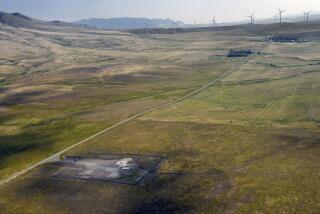The precise locations of these silos are...
- Share via
The precise locations of these silos are known to the Pentagon and Kremlin, but many residents of the Great Plains, who pass by them daily on the way to school, church or the farm, aren’t even aware that they exist, seeing only a few poles and metal parts around a large concrete slab. “They look like someone started to build a house and ran out of money, covered it over with cement, and put a fence around it,” says one rancher quoted here. By de-mystifying the locations of the silos through detailed maps and directions. Samuel H. Day Jr., former editor of The Bulletin of Atomic Scientists, hopes to create a new set of symbols around which anti-nuclear activists can rally. “The silos,” he writes, “are needles capable of pricking a public long numbed to the nuclear danger.”
Day is quite successful at constructing a new leftist liturgy: Realizing that the original names of the sites--E46, C21--were not much to build a movement around, he seems to have plumbed his thesaurus for all of the words under “destruction,” re-christening the sites with names such as “Doomsday Launch Control Center” and “Sleeping Auschwitz Missile.” For the unconverted, Day also offers essays which alert us to problems without resorting to partisan rhetoric. Residents of the region have been seriously misinformed, one piece persuasively argues, quoting articles in local papers which erroneously claim that America has ruled out first use of nuclear weapons and interviewing police officers who say they were told that an area “around 300 yards” would be in danger if one of the missiles exploded (the actual area can stretch up to 10 miles). While a staunchly leftist introductory essay by Philip Berrigan is sure to turn off conservative readers (he compares Red scares to Hitler’s savagery), this is a valuable book all in all, for it comes at a time when good U.S.-Soviet relations have tempted us to forget that the machinery of destruction is still in good working order, ticking under our ground.
More to Read
Sign up for Essential California
The most important California stories and recommendations in your inbox every morning.
You may occasionally receive promotional content from the Los Angeles Times.










